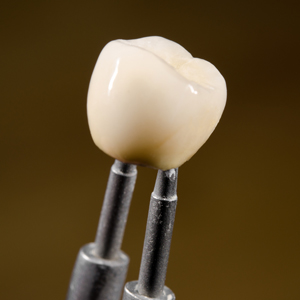
BACKGROUND: Mr D attends the dental surgery for an emergency appointment, complaining of pain in LR6. Following detailed examination, a radiograph is taken that shows caries beneath a deep restoration, encroaching upon the pulp. Periodontal pocketing is also noted on the distal aspect of the tooth.
The radiographic findings are discussed with the patient along with treatment options, including extraction or root canal therapy (RCT) under the NHS or privately with an endodontic specialist. Mr D opts for RCT with a specialist and, with patient consent, Dr N provides a referral.
The RCT is undertaken without incident and Mr D returns to Dr N for crown preparation. When Dr N removes the temporary filling, he notes extensive tooth destruction due to pre-existing decay. Dr N provides a core in composite material and prepares the tooth for a crown. However, he does not discuss the limitations of finishing the crown margin on core material and this is not recorded in the patient’s dental records.
Two weeks later Mr D returns to the practice for placement of the crown. A post-procedure periapical radiograph shows a deep distal aspect to the crown with some loss of periodontal bone. There is also a gap between the crown margin and core material. This is not reported on by Dr N.
Mr D has to relocate for work and registers with a new dental practice. Just over a month later he attends for an emergency appointment and reports loss of the crown at LR6. His new dentist advises that there is "not much tooth left" and Mr D agrees to an extraction, but the tooth fractures. Mr D is referred to a local dental hospital for surgical removal of the retained roots.
A letter of claim is sent to Dr N alleging clinical negligence in the treatment of LR6. It cites a failure to remove caries before placement of the restoration (evidenced in the radiographs) and a poorly fitting crown – specifically in that the distal crown margin is not resting on sound tooth structure.
ANALYSIS/OUTCOME: MDDUS instructs an expert general dental practitioner to review the case. Examining the post-operative radiograph taken by Dr N following crown placement, the expert is of the opinion that the caries was removed prior to placement of the core. She states that the image clearly shows radiolucent core material extending to the distal cavity margin.
It is in the placement of the crown that the expert finds fault. She states that it is standard that the crown margin should finish on sound tooth substance and should fit flush with the surface in order to create an adequate seal to reduce the risk of secondary decay developing. The post-operative radiograph in this case shows that the crown margin finished on composite core material rather than sound tooth and with an obvious gap.
The expert concludes that taking no action to correct these deficiencies in treatment constitutes a breach of duty of care.
In regard to causation (adverse consequences of the breach) the expert opines that LR6 probably had a poor prognosis before treatment by Dr N , with distal caries extending below gum level and close to the crest of the inter-proximal bone between LR6 and LR7. Achieving a satisfactory crown preparation margin would have been difficult in any event and she estimates the tooth would have been lost within ten years.
Considering expert opinion on the case, MDDUS decides in agreement with the member to settle for a sum based on the cost of replacement implant treatment.
KEY POINTS
- Ensure patients have realistic expectations of treatment outcomes.
- Correct treatment deficiencies when identified – do not simply ‘hope for the best’.
This page was correct at the time of publication. Any guidance is intended as general guidance for members only. If you are a member and need specific advice relating to your own circumstances, please contact one of our advisers.
Save this article
Save this article to a list of favourite articles which members can access in their account.
Save to library
